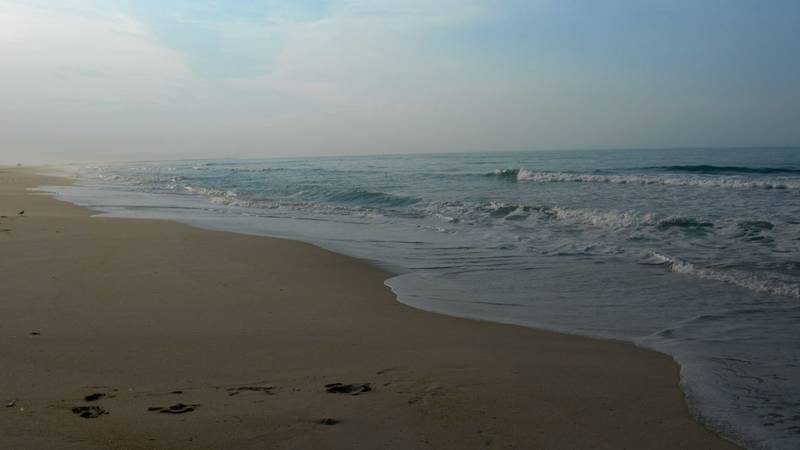This month marks the 25th anniversary of the North Carolina icon being moved inland from the encroaching ocean. The famous beacon is now undergoing a major renovation to restore its 19th-century luster.
The Cape Hatteras Light Station protects one of the most hazardous sections of the East Coast, known as the “graveyard of the Atlantic” because so many ships have wrecked along a dangerous 12-mile-long sandbar, called Diamond Shoals.
The site features the tallest brick lighthouse in the U.S., at 198 feet. The Coast Guard still operates the light, while the National Park Service maintains the lighthouse and its keepers’ quarters as part of Cape Hatteras National Seashore — 70 miles of barrier islands along the North Carolina coast.
An icon of the Outer Banks, the lighthouse’s black and white swirl adorns artwork, T-shirts, mugs and other paraphernalia sold throughout the state. The Park Service even offers a step-by-step guide for knitting the Cape Hatteras Lighthouse.
But this site, which half a million people visit each year, isn’t the lighthouse’s first home.
Cape Hatteras Lighthouse originally stood about half a mile away, on a sandy hill 1,500 feet from the shoreline. Because Hatteras is a barrier island, its sands continuously shift. By 1970, waves lapped just 120 feet away from the towering beacon. Federal agencies had made attempts to stabilize the coast by adding support walls and sand since the 1930s but had been unsuccessful in stopping nature.
Fearing the lighthouse would be lost, the National Park Service undertook an impressive relocation process in June 1999 that earned it the Outstanding Civil Engineering Achievement award from the American Society of Civil Engineering the following year.

Cape Hatteras Lighthouse is painted with white and black spirals to make it visible from the ocean during the day.
NPSThe lighthouse rises as a cone from an octagon-shaped brick and granite base, topped with an iron and glass lantern. The Cape Hatteras Light Station includes the lighthouse, oil house, principal keeper’s house quarters and double keepers’ quarters.
The Park Service had begun long-term planning for how to save these historic structures in the 1980s. In a special report, scientists and engineers presented the agency with 10 options for how to save the lighthouse, in particular, from continued erosion and rising sea levels.
Relocating the lighthouse appeared to be the most cost-effective step. Public debate ensued, however, with many people fearing the move would destroy the lighthouse. In 1996, an independent review by North Carolina State University of the previously presented options motivated the Park Service to take action. Congress approved funding for the relocation in 1998, and International Chimney Corp. of Buffalo, New York, received the project’s contract.
Workers separate the Cape Hatteras Lighthouse from its foundation on Feb. 22, 1999, in preparation to move the structure inland using hydraulic lifts, rollers and a rail system.
NPSA row of 100-ton jacks used to lift up the Cape Hatteras Lighthouse.
NPSThe Cape Hatteras Lighthouse, pictured June 24, 1999, makes its slow progression on rollers and a rail system toward its new home further inland. The move took 23 days.
NPS
A “lighthouse crossing” sign made by National Park Service employees, which they placed at the park site’s entrance road.
NPSThe Principal Keeper’s Quarters and Double Keepers’ Quarters atop new pilings and foundations at the new site for the Cape Hatteras Light Station on June 3, 1999.
NPSCape Hatteras Lighthouse at its new location after the 1999 move.
NPSOn June 17, 1999, using hydraulic lifts, rollers and a rail system, crews began moving the monolith 2,900 feet inland — nearly the length of 10 football fields. Earlier that year, the Park Service had a 100-foot-wide path cleared for the move, and workers used a diamond-tipped cable saw to separate the lighthouse from its foundation.
Workers moved the lighthouse on the rollers, 5 feet at time, each push taking a minute. After 23 days, the lighthouse reached its new home on July 9 — once again perched at a spot 1,500 feet from the shoreline.
A quarter century later, the Park Service has a $19.2 million project underway to restore and rehabilitate the Cape Hatteras Lighthouse inside and out. Led by Stone & Lime Historic Restoration Services Inc. of Massachusetts, the work began in late 2023 and is expected to last 18 months. While visitors cannot climb the lighthouse’s 269 steps to the top during the renovation (there are typically 1,500 climbers a day between April and October), the park store, restrooms and varying parts of the grounds remain open.
Vulnerability assessments along the national seashore have rated some of the park site’s assets, such as campgrounds, roads, parking lots and historic buildings, at critical risk from sea-level rise over the coming decades, but the area surrounding the Cape Hatteras Light Station’s new location is considered at low to moderate risk.

Shoreline Erosion at Cape Hatteras National Seashore
Collapsing homes and beach debris create new challenges for the National Park Service.
See more ›More harmful is the salt air, high winds and intense sunlight that continuously weather the lighthouse. Based on condition assessments in 2014 and 2016, the restoration and rehabilitation project includes repainting the interior and exterior, restoring ironwork with non-corrosive materials, repairing masonry and restoring architectural components, such as the ornamental features above the lighthouse windows.
The Park Service is also expanding the park site’s sidewalks and historical interpretation along the walkways and restoring fencing around the keeper’s quarters. The lighthouse’s beacon is being replaced with a replica of an original Fresnel lens.

Inside the Cape Hatteras Lighthouse.
NPSThe investment will “restore the lighthouse’s condition and bring back character defining architectural features as they were in 1870,” said David Hallac, superintendent of the National Parks of Eastern North Carolina, in a news release. Park enthusiasts can follow the progress on the project update webpage.
Want to visit?
The Cape Hatteras Light Station is located in Buxton, North Carolina, roughly in the middle of Cape Hatteras National Seashore. The seashore protects parts of three barrier islands — Bodie Island, Hatteras Island and Ocracoke Island — and each island features its own lighthouse. Beach activities, fishing, birding and more draw visitors here. The seashore has no entrance fee. Visitors can access it from the northern entrance at the junction of US-64 and NC-12 in Nags Head, or the southern entrance on NC-12 just north of Ocracoke Village, which is accessible only by ferry.
Stay On Top of News
Our email newsletter shares the latest on parks.
About the author
-
 Linda Coutant Staff Writer
Linda Coutant Staff WriterAs staff writer on the Communications team, Linda Coutant manages the Park Advocate blog and coordinates the monthly Park Notes e-newsletter distributed to NPCA’s members and supporters. She lives in Western North Carolina.





